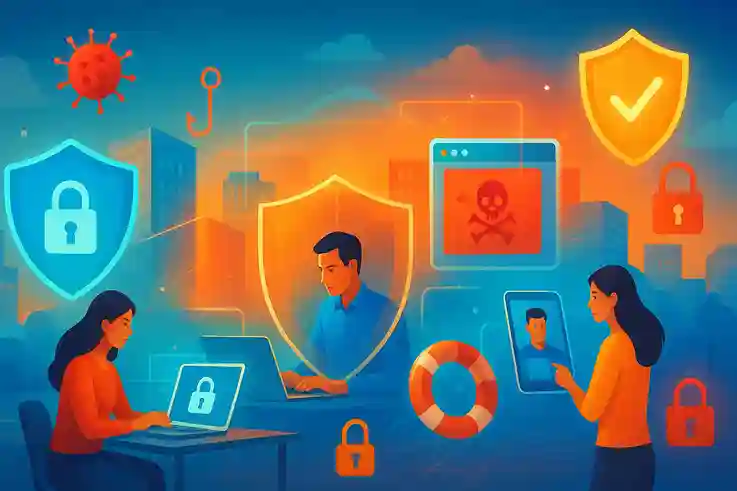Digital Resilience is the ability to protect, recover, and thrive in a connected world, where our most valuable information—from family photos and personal messages to financial accounts—exists online. Every day, cyber threats are growing more sophisticated, making it essential to safeguard your digital life. Without the right strategies, data breaches, identity theft, or even simple device failures can cause serious disruption.
In this blog, we’ll dive into the concept of digital resilience, explain why it matters in today’s connected world, and share practical tips to protect your data, strengthen your online safety, and improve your overall digital literacy. By the end, you’ll have actionable steps to secure the digital aspects of your life and enjoy technology with confidence.
What Is Digital Resilience?

Digital Resilience is the ability to prepare for, recover from, and adapt to digital threats. Unlike basic cybersecurity, which focuses mainly on preventing attacks, digital resilience also emphasizes bouncing back quickly and maintaining control when things go wrong.
Everyday examples make it clear why this matters:
Recovering a hacked social media account without losing important data
If your account is hacked, act quickly: change your password, enable multi-factor authentication, and check connected apps for suspicious activity. Report the breach to the platform and review your privacy settings. Backing up important photos and messages ensures you don’t lose valuable data while restoring control.
Bouncing back from a phishing attempt and avoiding further risks
If you fall for a phishing attempt, don’t panic. Immediately change passwords for affected accounts and scan your devices for malware. Learn to recognize phishing signs, such as suspicious links or unexpected requests, to prevent future attacks. Strengthening your online safety habits helps you recover quickly and reduces the risk of repeated attacks.
Keeping children safe from online scams while teaching them good habits
Teach children to recognize suspicious links, messages, or pop-ups and never share personal information online. Set up parental controls on devices and monitor online activity without being intrusive. Encourage open conversations about online experiences so they can ask for help if something feels wrong. These steps build both digital literacy and long-term digital resilience.
Building digital resilience means combining cyber security tips, online safety, and digital literacy so you can confidently navigate a connected world.
Why Digital Resilience Matters Today

Rising Cybercrime Rates
Cybercrime in the U.S. is growing at an alarming pace. Identity theft, ransomware, and phishing attacks target millions every year, affecting both individuals and businesses. These threats often compromise sensitive personal data, including financial information, private communications, and login credentials. The rising number of cyber incidents demonstrates that online safety is no longer optional—it is a crucial part of modern life.
More Exposure in a Connected World
Our reliance on digital tools has skyrocketed. Remote work, online banking, e-learning, and cloud storage make life convenient but also increase vulnerability. Every device, app, or connected account can become a target for cyberattacks. Developing digital resilience helps safeguard personal and professional information, ensuring you can navigate a highly connected world without constant fear of compromise.
The Emotional Cost of Digital Threats
Cyber incidents carry more than financial consequences—they also affect mental and emotional well-being. Losing cherished photos, important documents, or experiencing identity theft can cause stress, frustration, and anxiety. By prioritizing digital resilience, you not only protect your data but also gain peace of mind, knowing you can recover quickly from unexpected digital setbacks.
“According to the U.S. Cybersecurity and Infrastructure Security Agency (CISA), adopting best practices like strong passwords, multi-factor authentication, and regular software updates is crucial for maintaining digital resilience and protecting your online data.”
The Pillars of Digital Resilience

Awareness
The first step in building digital resilience is awareness. Being able to recognize scams, phishing attempts, and fake news can prevent costly mistakes and data loss. Understanding the common tactics that cybercriminals use helps you make safer decisions online. By regularly improving your digital literacy, you strengthen your ability to spot threats and protect yourself, your family, and your personal information in a highly connected world.
Protection
Protection is about actively defending your digital life with practical tools and habits. Using strong, unique passwords for every account, enabling two-factor authentication (2FA), and installing reputable antivirus software are essential first steps. A virtual private network (VPN) adds an extra layer of security, especially when using public Wi-Fi. Following these cyber security tips consistently helps ensure your personal and financial information remains safe, strengthening your overall digital resilience.
Recovery
Recovery acknowledges that even with strong protection, cyber incidents can still happen. Effective strategies include regularly backing up important files, using password managers to securely store and generate passwords, and keeping software and devices updated with the latest security patches. A well-planned recovery approach minimizes data loss, reduces downtime, and helps you regain control quickly, reinforcing your overall digital resilience and maintaining your online safety.
Adaptability
Adaptability is essential because digital threats are constantly evolving. AI-driven scams, deepfakes, and new malware emerge regularly, targeting unsuspecting users. Staying informed about these developments and updating your security practices ensures your defenses remain effective. By making adaptability a core part of your digital resilience, you can respond proactively to emerging threats, reduce risk, and maintain control over your personal and professional digital life.
The Four Pillars of Digital Resilience
| Pillar | Key Actions / Tips | Benefits |
|---|---|---|
| Awareness | Recognize scams, phishing, and fake news | Prevents attacks, improves digital literacy |
| Protection | Strong passwords, 2FA, antivirus, VPN | Secures devices and accounts, reduces vulnerability |
| Recovery | Backups, password managers, security updates | Minimizes data loss, ensures quick recovery |
| Adaptability | Stay updated on threats (AI scams, deepfakes), update security practices | Responds proactively to evolving threats, maintains overall resilience |
How to Build Digital Resilience at Home
Secure Your Wi-Fi and Keep Devices Updated
Start by securing your home network with strong, unique Wi-Fi passwords and encryption. Ensure all devices, apps, and software are updated regularly with the latest security patches. These updates fix vulnerabilities that cybercriminals often exploit. Maintaining this routine is a simple yet powerful way to enhance online safety and reinforce your household’s digital resilience.
Use Parental Controls for Kids
Protect children from online threats by enabling parental controls on devices, apps, and web browsers. Monitor their activity subtly, without being intrusive, and guide them on safe browsing, password habits, and recognizing suspicious links. Consistently teaching these practices strengthens their digital literacy and builds long-term digital resilience, giving them the skills to navigate a connected world safely.
Backup Important Files
Regularly back up important documents, photos, and other essential data using both cloud storage and offline solutions, such as external hard drives or USBs. These backups ensure that even if a device is lost, hacked, or fails, your information remains safe. Making backups a consistent habit is a key step in maintaining digital resilience and protecting your most valuable digital assets.
Teach Safe Browsing to Kids and Elderly
Everyone in the household benefits from understanding online risks. Teach children and elderly family members to recognize suspicious links, avoid phishing attempts, and practice safe browsing habits. Pair this awareness with practical cyber security tips, such as using strong passwords and enabling updates, to significantly reduce the likelihood of digital incidents. Building these skills across all family members strengthens overall digital resilience at home.
Practical Checklist for Families
- Secure Wi-Fi and strong passwords
- Enable device and app updates
- Use parental controls and monitor online activity
- Backup files to cloud and offline storage
- Teach safe browsing habits to all family members
Following these steps creates a safer home environment and helps families develop strong digital resilience habits.
Protecting Data at Work and School
Use Official Platforms Only
Ensure that all learning, communication, and collaboration take place on official, secure platforms. Avoid unverified apps or third-party tools that might expose sensitive personal or organizational information. Using trusted platforms not only protects data but also reinforces online safety and strengthens overall digital resilience in schools and workplaces.
Cyber Hygiene Training
Provide ongoing cyber hygiene training for employees, students, and staff to keep them aware of evolving digital threats. Cover key topics such as recognizing phishing emails, creating and managing strong passwords, and sharing data securely. Strengthening digital literacy in the workplace or school environment builds a culture of security and reinforces overall digital resilience.
Regular Password Audits and Account Monitoring
Conduct regular password audits and actively monitor accounts for any unusual or suspicious activity. Encourage all users to enable multi-factor authentication (2FA) and use strong, unique passwords for each account. These practices reduce vulnerabilities, prevent potential breaches, and strengthen overall digital resilience in both work and school environments.
Disaster Recovery Plans
Establish comprehensive disaster recovery plans for schools and businesses to prepare for potential cyber incidents. Include clear protocols for regular data backups, secure system restoration, and timely communication during an attack. Having a well-defined recovery plan minimizes disruption, protects sensitive information, and reinforces overall digital resilience across the organization.
Digital Resilience at Home vs. Work/School
| Environment | Key Practices | Benefits |
|---|---|---|
| Home | Secure Wi-Fi, backups, parental controls, teach safe browsing | Protects family data, strengthens digital literacy, ensures online safety |
| Work / School | Official platforms only, cyber hygiene training, password audits, disaster recovery plans | Protects organizational data, reduces breaches, promotes responsible behavior |
Protecting What You Love in a Connected Age
Family Safety
Protecting your family online begins with safe social media sharing and securing all accounts. Use strong, unique passwords, enable privacy settings, and activate parental controls on devices and apps. Educate children about recognizing scams, suspicious links, and unsafe websites. Following these practices not only strengthens digital resilience but also ensures that every family member can navigate a highly connected world safely.
Financial Security
Keep your finances secure by relying only on trusted online banking and payment platforms. Enable multi-factor authentication (2FA) for added protection and monitor accounts regularly for unusual activity. Avoid clicking on suspicious links or emails while shopping online, as these are common tactics for cybercriminals. Consistently following these cyber security tips helps safeguard your money and sensitive financial information, reinforcing your overall digital resilience.
Preserving Memories
Photos and videos often hold priceless memories. Protect them by regularly backing up your data to both secure cloud storage and offline devices, such as external hard drives. This ensures that even if a device is lost, stolen, or compromised, your memories remain safe and accessible. Maintaining this habit strengthens your digital resilience and provides peace of mind in a highly connected world.
Protecting Your Reputation
Protect your reputation by regularly monitoring your digital footprint and online identity. Review social media posts, tags, and privacy settings to ensure personal information isn’t exposed unintentionally. Being mindful of what you share and understanding how your data can be used helps reduce reputational risks and strengthens overall online safety and digital resilience.
The Future of Digital Resilience
AI and Machine Learning in Cybersecurity
Artificial intelligence (AI) and machine learning are revolutionizing cybersecurity by detecting threats faster and more accurately than traditional methods. These technologies can automate responses, identify suspicious patterns in real-time, and even predict potential attacks before they happen. Staying informed about AI-driven security tools and incorporating them into your routines will be essential for maintaining strong digital resilience in an increasingly complex and rapidly evolving threat landscape.
Growing Need for Digital Literacy
As misinformation, deepfakes, and increasingly sophisticated scams become widespread, developing strong digital literacy is essential. Learning to verify sources, recognize fake content, and critically assess online information empowers individuals to make safer choices. These skills help protect personal data, maintain online safety, and strengthen digital resilience in today’s highly connected world.
Digital Resilience as a Life Skill
Digital resilience is emerging as a life skill as essential as financial literacy or basic health knowledge. By adopting habits such as secure data management, regular backups, strong password practices, and safe online behavior, individuals can safeguard themselves and their families.
Treating digital resilience as a core skill ensures long-term online safety, builds confidence in navigating the digital world, and enhances adaptability to future cyber threats.
FAQs
Conclusion
Digital resilience is more than defending against cyber threats—it’s about preparing, recovering, and adapting to keep your digital life safe. In a highly connected world, our personal data, family memories, finances, and reputations are constantly at risk. Building digital resilience ensures you can respond effectively to incidents while maintaining control.
Simple steps—like using strong passwords, enabling two-factor authentication (2FA), backing up data, and teaching safe online habits—make a significant difference. Strengthening digital literacy and staying informed about evolving threats, such as AI-driven scams and deepfakes, further enhances your ability to protect yourself and your loved ones.
Take control of your digital life today.
Share your own tips or experiences in the comments to help others strengthen their digital resilience in a connected world.

Ellie Clark is a passionate blogger with a specialty in education, where she shares insights on learning methods, study strategies, and ways to make knowledge more accessible. With a background in teaching and a love for lifelong learning, she brings clarity and creativity to her writing, helping readers of all ages unlock their potential. While education remains her core focus, Ellie also writes on a variety of other topics, including lifestyle, travel, and personal development, giving her blog a well-rounded appeal.
When she’s not writing, Ellie enjoys reading, exploring new cultures, and spending time in nature. Her approachable style and thoughtful advice make her a trusted voice for readers seeking both guidance and inspiration.


